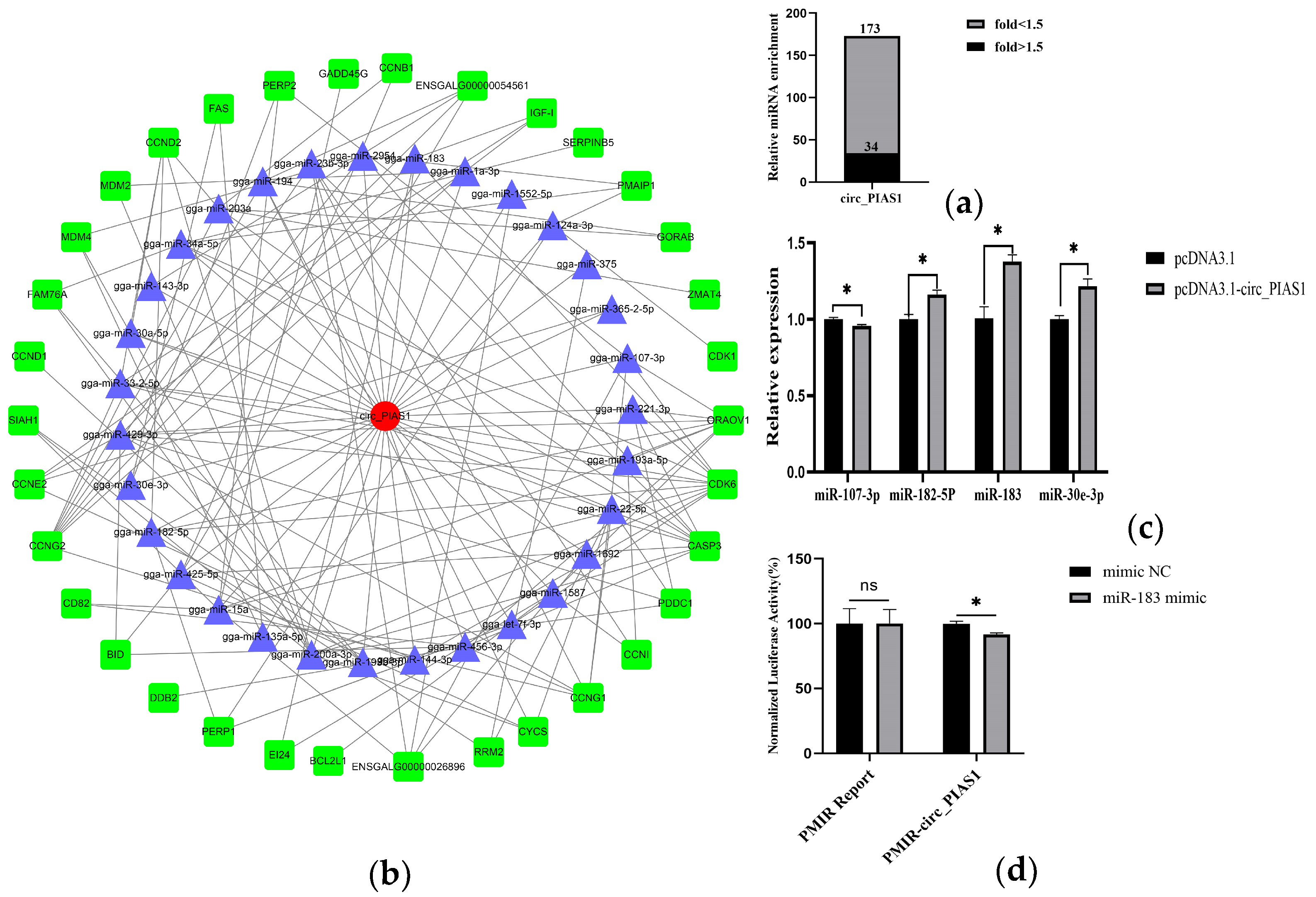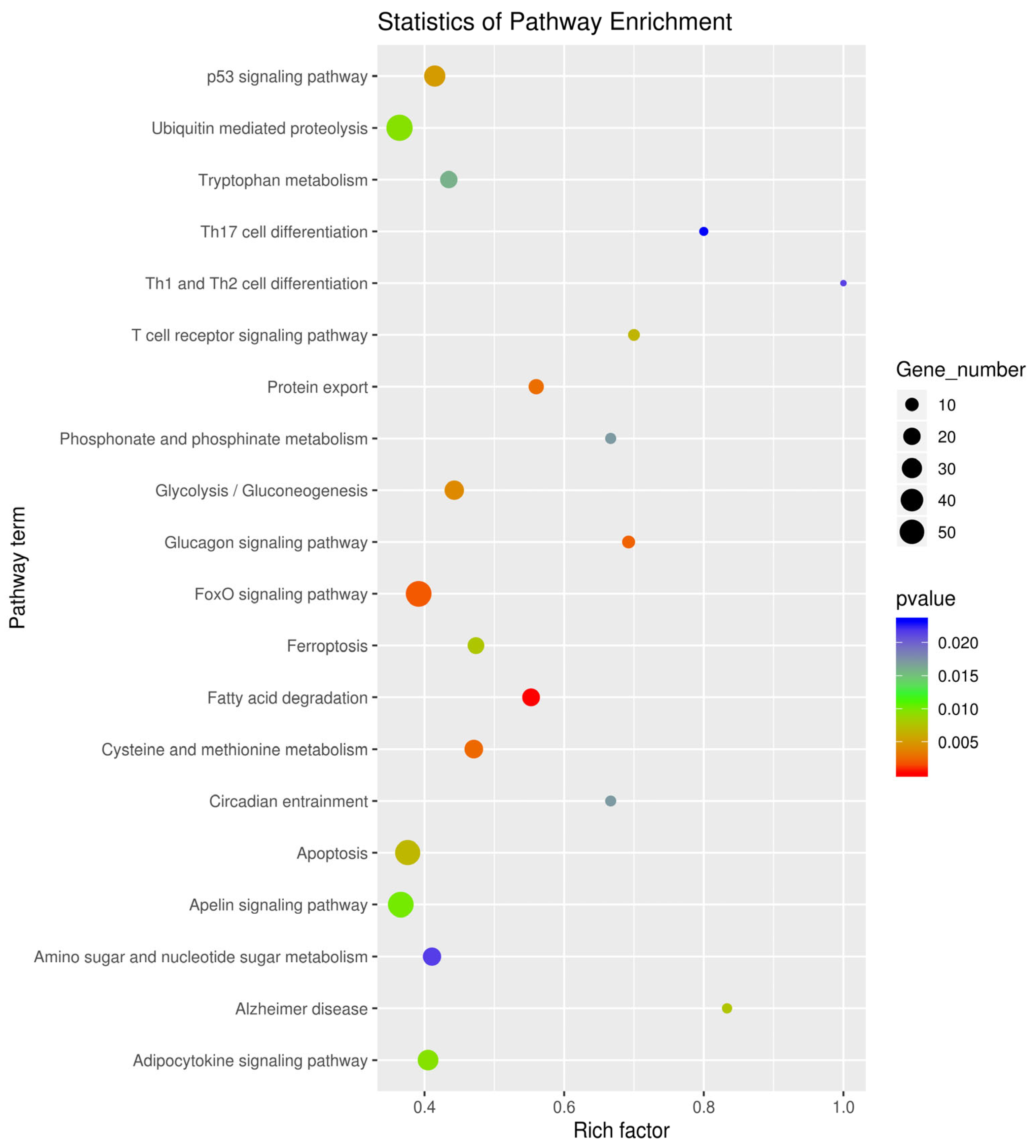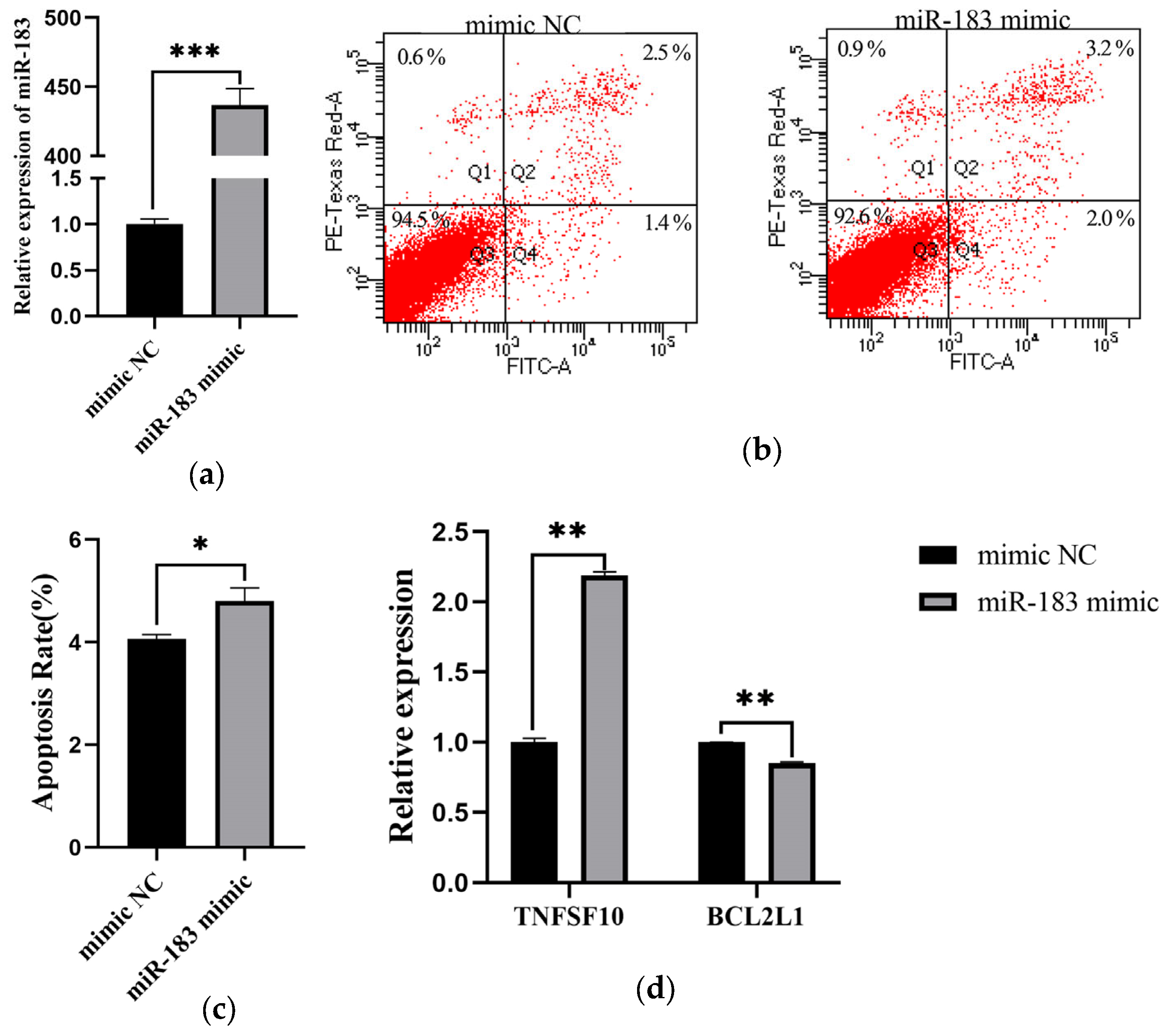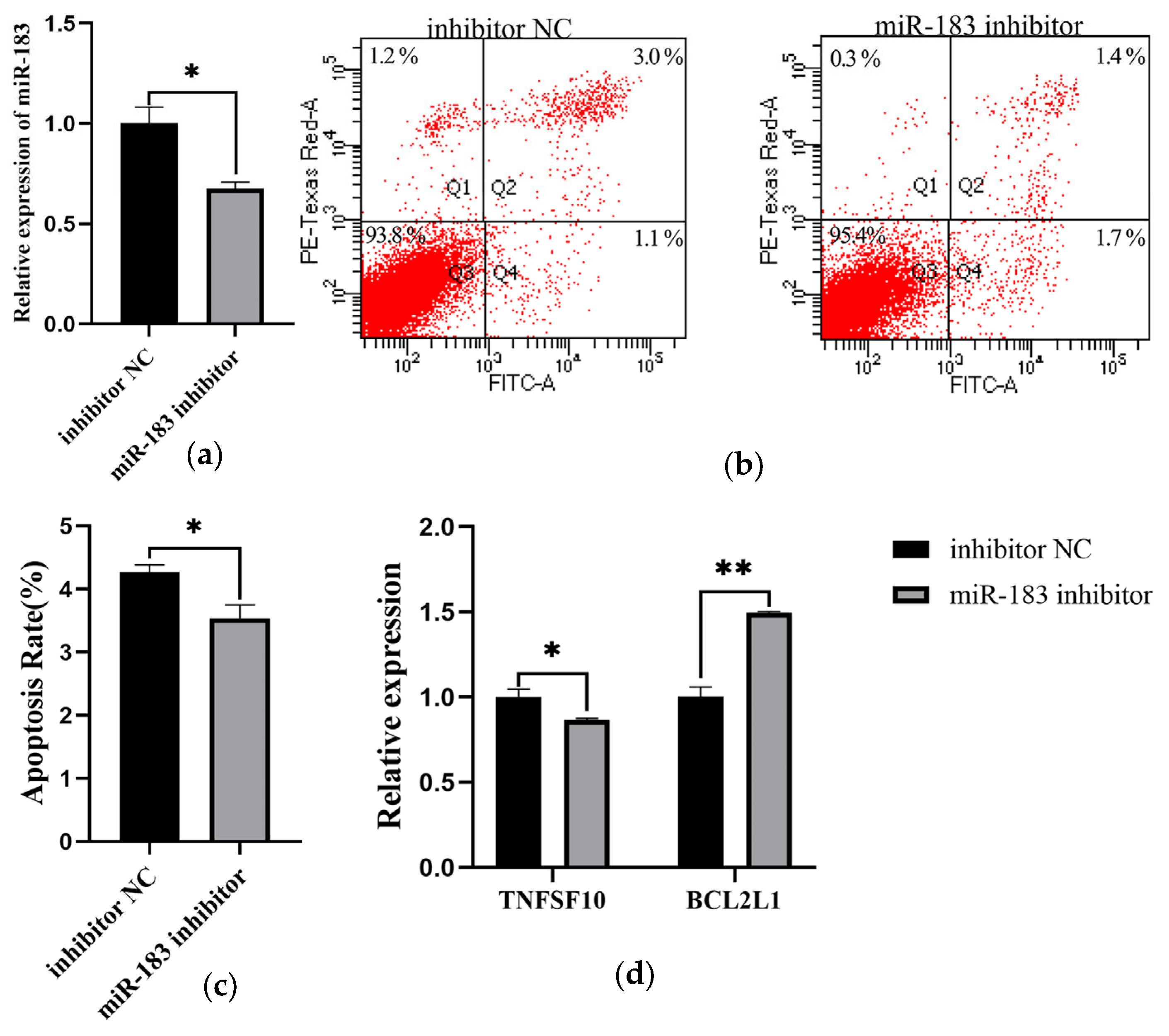Circ_PIAS1 Promotes the Apoptosis of ALV-J Infected DF1 Cells by Up-Regulating miR-183
Abstract
1. Introduction
2. Materials and Methods
2.1. Cell Culture
2.2. Vectors Construction
2.3. ALV-J Infected DF-1 Cells
2.4. Western Blot
2.5. Total RNA Extraction, cDNA Synthesis, and qRT-PCR
2.6. Cell Apoptosis Assay
2.7. Dual-Luciferase Reporter Assay
2.8. RNA Pull-Down
2.9. Statistical Analysis
3. Results
3.1. Circ_PIAS1 Promotes the Apoptosis of ALV-J Infected DF1 Cells
3.2. Bioinformatic Analysis of Biotin-Labeled RNA Pull-Down Analysis
3.3. Overexpression of miR-183 Increases the Apoptosis of ALV-J Infection DF1 Cells
3.4. Inhibition of miR-183 Decreases the Apoptosis of ALV-J Infection DF1 Cells
4. Discussion
5. Conclusions
Supplementary Materials
Author Contributions
Funding
Institutional Review Board Statement
Informed Consent Statement
Data Availability Statement
Acknowledgments
Conflicts of Interest
References
- Sanger, H.L.; Klotz, G.; Riesner, D.; Gross, H.J.; Kleinschmidt, A.K. Viroids are single-stranded covalently closed circular RNA molecules existing as highly base-paired rod-like structures. Proc. Natl. Acad. Sci. USA 1976, 73, 3852–3856. [Google Scholar] [CrossRef] [PubMed]
- Jeck, W.R.; Sharpless, N.E. Detecting and characterizing circular RNAs. Nat. Biotechnol. 2014, 32, 453–461. [Google Scholar] [CrossRef]
- Qu, S.; Yang, X.; Li, X.; Wang, J.; Gao, Y.; Shang, R.; Sun, W.; Dou, K.; Li, H. Circular RNA: A new star of noncoding RNAs. Cancer Lett. 2015, 365, 141–148. [Google Scholar] [CrossRef]
- Chen, X.; Ouyang, Z.; Shen, Y.; Liu, B.; Zhang, Q.; Wan, L.; Yin, Z.; Zhu, W.; Li, S.; Peng, D. CircRNA_28313/miR-195a/CSF1 axis modulates osteoclast differentiation to affect OVX-induced bone absorption in mice. RNA Biol. 2019, 16, 1249–1262. [Google Scholar] [CrossRef]
- White, M.C.; Lowen, A.C. Implications of segment mismatch for influenza A virus evolution. J. Gen. Virol. 2018, 99, 3–16. [Google Scholar] [CrossRef]
- Chen, L.; Xu, Y. MicroRNAs as Biomarkers and Therapeutic Targets in Doxorubicin-Induced Cardiomyopathy: A Review. Front. Cardiovasc. Med. 2021, 8, 740515. [Google Scholar] [CrossRef]
- Imperatore, J.A.; Cunningham, C.L.; Pellegrene, K.A.; Brinson, R.G.; Marino, J.P.; Evanseck, J.D.; Mihailescu, M.R. Highly conserved s2m element of SARS-CoV-2 dimerizes via a kissing complex and interacts with host miRNA-1307-3p. Nucleic Acids Res. 2022, 50, 1017–1032. [Google Scholar] [CrossRef]
- Zeng, Y.; Yi, R.; Cullen, B.R. MicroRNAs and small interfering RNAs can inhibitmRNA expression by similar mechanisms. PNAS 2003, 100, 9779–9784. [Google Scholar] [CrossRef] [PubMed]
- Bartel, D.P.; Chen, C.Z. Micromanagers of gene expression the potentially widespread influence of metazoan microRNAs. Nature 2004, 5, 396–400. [Google Scholar] [CrossRef]
- Zhang, S.; Gu, D.; Ouyang, X.; Xie, W. Proinflammatory effects of the hemagglutinin protein of the avian influenza A (H7N9) virus and microRNA-mediated homeostasis response in THP-1 cells. Mol. Med. Rep. 2015, 12, 6241–6246. [Google Scholar] [CrossRef] [PubMed]
- Chen, Y.; Liu, W.; Xu, H.; Liu, J.; Deng, Y.; Cheng, H.; Zhu, S.; Pei, Y.; Hu, J.; Hu, Z.; et al. MicroRNA Expression Profiling in Newcastle Disease Virus-Infected DF-1 Cells by Deep Sequencing. Front. Microbiol. 2019, 10, 1659. [Google Scholar] [CrossRef]
- Song, L.; Liu, H.; Gao, S.; Jiang, W.; Huang, W. Cellular microRNAs inhibit replication of the H1N1 influenza A virus in infected cells. J. Virol. 2010, 84, 8849–8860. [Google Scholar] [CrossRef]
- Zhang, S.; Li, J.; Li, J.; Yang, Y.; Kang, X.; Li, Y.; Wu, X.; Zhu, Q.; Zhou, Y.; Hu, Y. Up-regulation of microRNA-203 in influenza A virus infection inhibits viral replication by targeting DR1. Sci. Rep. 2018, 8, 6797. [Google Scholar] [CrossRef] [PubMed]
- Huangfu, L.; Liang, H.; Wang, G.; Su, X.; Li, L.; Du, Z.; Hu, M.; Dong, Y.; Bai, X.; Liu, T.; et al. miR-183 regulates autophagy and apoptosis in colorectal cancer through targeting of UVRAG. Oncotarget 2015, 7, 4735–4746. [Google Scholar] [CrossRef]
- Zhou, J.; Zhang, C.; Zhou, B.; Jiang, D. miR-183 modulated cell proliferation and apoptosis in ovarian cancer through the TGF-β/Smad4 signaling pathway. Int. J. Mol. Med. 2019, 43, 1734–1746. [Google Scholar] [CrossRef] [PubMed]
- Hu, Q.G.; Yang, Z.; Chen, J.W.; Kazobinka, G.; Tian, L.; Li, W.C. MiR-183-5p-PNPT1 Axis Enhances Cisplatin-induced Apoptosis in Bladder Cancer Cells. Curr. Med. Sci. 2022, 42, 785–796. [Google Scholar] [CrossRef] [PubMed]
- Yang, T.; Qiu, L.; Bai, M.; Wang, L.; Hu, X.; Huang, L.; Chen, G.; Chang, G. Identification, biogenesis and function prediction of novel circRNA during the chicken ALV-J infection. Anim. Biotechnol. 2022, 33, 981–991. [Google Scholar] [CrossRef]
- Chen, G.; Liu, T.; Yu, B.; Wang, B.; Peng, Q. CircRNA-UBE2G1 regulates LPS-induced osteoarthritis through miR-373/HIF-1a axis. Cell Cycle 2020, 19, 1696–1705. [Google Scholar] [CrossRef]
- Huang, G.; Liang, M.; Liu, H.; Huang, J.; Li, P.; Wang, C.; Zhang, Y.; Lin, Y.; Jiang, X. CircRNA hsa_circRNA_104348 promotes hepatocellular carcinoma progression through modulating miR-187-3p/RTKN2 axis and activating Wnt/β-catenin pathway. Cell Death Dis. 2020, 11, 1065. [Google Scholar] [CrossRef]
- Qiu, L. Mechanism of Circ_2420-Bcl11b-Mediated Apoptosis in Regulating ALV-J INFECTION in Chickens. Ph.D. Thesis, Yangzhou University, Yangzhou, China, 2020. [Google Scholar]
- Huang, Z.; Ma, W.; Xiao, J.; Dai, X.; Ling, W. CircRNA_0092516 regulates chondrocyte proliferation and apoptosis in osteoarthritis through the miR-337-3p/PTEN axis. J. Biochem. 2021, 169, 467–475. [Google Scholar] [CrossRef]
- Li, X.; Zhang, Y.; Wang, N.; Yuan, Z.; Chen, X.; Chen, Q.; Deng, H.; Tong, X.; Chen, H.; Duan, Y.; et al. CircRNA.0007127 triggers apoptosis through the miR-513a-5p/CASP8 axis in K-562 cells. J. Zhejiang Univ. Sci. B 2022, 23, 732–746. [Google Scholar] [CrossRef]
- Shao, Y.; Li, M.; Yu, Q.; Gong, M.; Wang, Y.; Yang, X.; Liu, L.; Liu, D.; Tan, Z.; Zhang, Y.; et al. CircRNA CDR1as promotes cardiomyocyte apoptosis through activating hippo signaling pathway in diabetic cardiomyopathy. Eur. J. Pharmacol. 2022, 922, 174915. [Google Scholar] [CrossRef]
- Qiao, L.; Li, C.G.; Liu, D. CircRNA_0048211 protects postmenopausal osteoporosis through targeting miRNA-93-5p to regulate BMP2. Eur. Rev. Med. Pharmacol. Sci. 2020, 24, 3459–3466. [Google Scholar]
- Liu, J.; Xue, N.; Guo, Y.; Niu, K.; Gao, L.; Zhang, S.; Gu, H.; Wang, X.; Zhao, D.; Fan, R. Correction for: CircRNA_100367 regulated the radiation sensitivity of esophageal squamous cell carcinomas through miR-217/Wnt3 pathway. Aging 2021, 13, 23868–23870. [Google Scholar] [CrossRef] [PubMed]
- Cortés-López, M.; Miura, P. Emerging Functions of Circular RNAs. Yale J. Biol. Med. 2016, 89, 527–537. [Google Scholar]
- Wang, K.; Gan, T.Y.; Li, N.; Liu, C.Y.; Zhou, L.Y.; Gao, J.N.; Chen, C.; Yan, K.W.; Ponnusamy, M.; Zhang, Y.H.; et al. Circular RNA mediates cardiomyocyte death via miRNA-dependent upregulation of MTP18 expression. Cell Death Differ. 2017, 24, 1111–1120. [Google Scholar] [CrossRef]
- Li, X.; Zheng, Y.; Zheng, Y.; Huang, Y.; Zhang, Y.; Jia, L.; Li, W. Circular RNA CDR1as regulates osteoblastic differentiation of periodontal ligament stem cells via the miR-7/GDF5/SMAD and p38 MAPK signaling pathway. Stem. Cell Res. Ther. 2018, 9, 232. [Google Scholar] [CrossRef]
- Zhang, X.; Yan, Y.; Lin, W.; Li, A.; Zhang, H.; Lei, X.; Dai, Z.; Li, X.; Li, H.; Chen, W.; et al. Circular RNA Vav3 sponges gga-miR-375 to promote epithelial-mesenchymal transition. RNA Biol. 2019, 16, 118–132. [Google Scholar] [CrossRef] [PubMed]
- Ouyang, H.; Chen, X.; Li, W.; Li, Z.; Nie, Q.; Zhang, X. Circular RNA circSVIL Promotes Myoblast Proliferation and Differentiation by Sponging miR-203 in Chicken. Front. Genet. 2018, 9, 172. [Google Scholar] [CrossRef] [PubMed]
- Li, W.; Song, Y.Y.; Rao, T.; Yu, W.M.; Ruan, Y.; Ning, J.Z.; Yao, X.B.; Yang, S.Y.; Cheng, F. CircCSNK1G3 up-regulates miR-181b to promote growth and metastasis via TIMP3-mediated epithelial to mesenchymal transitions in renal cell carcinoma. J. Cell Mol. Med. 2022, 26, 1729–1741. [Google Scholar] [CrossRef]
- Han, K.; Wang, F.W.; Cao, C.H.; Ling, H.; Chen, J.W.; Chen, R.X.; Feng, Z.H.; Luo, J.; Jin, X.H.; Duan, J.L.; et al. CircLONP2 enhances colorectal carcinoma invasion and metastasis through modulating the maturation and exosomal dissemination of microRNA-17. Mol. Cancer 2020, 19, 60. [Google Scholar] [CrossRef]
- Guo, J.U.; Agarwal, V.; Guo, H.; Bartel, D.P. Expanded identification and characterization of mammalian circular RNAs. Genome Biol. 2014, 15, 409–422. [Google Scholar] [CrossRef]
- You, X.; Vlatkovic, I.; Babic, A.; Will, T.; Epstein, I.; Tushev, G.; Akbalik, G.; Wang, M.; Glock, C.; Quedenau, C.; et al. Neural circular RNAs are derived from synaptic genes and regulated by development and plasticity. Nat. Neurosci. 2015, 18, 603–610. [Google Scholar] [CrossRef]
- Yin, X.; Cao, L.; Peng, Y.; Tan, Y.; Xie, M.; Kang, R.; Livesey, K.M.; Tang, D. A critical role for UVRAG in apoptosis. Autophagy 2011, 7, 1242–1244. [Google Scholar] [CrossRef] [PubMed]
- Zhao, M.; Mishra, L.; Deng, C.X. The role of TGF-β/SMAD4 signaling in cancer. Int. J. Biol. Sci. 2018, 14, 111–123. [Google Scholar] [CrossRef] [PubMed]
- Liu, X.; Fu, R.; Pan, Y.; Meza-Sosa, K.F.; Zhang, Z.; Lieberman, J. PNPT1 Release from Mitochondria during Apoptosis Triggers Decay of Poly(A) RNAs. Cell 2018, 174, 187–201.e12. [Google Scholar] [CrossRef]
- Li, M.; Liang, W.; Zhu, C.; Qin, S. Smad4 mediates Bmf involvement in sheep granulosa cell apoptosis. Gene 2022, 817, 146231. [Google Scholar] [CrossRef] [PubMed]
- Gong, Y.; Dai, H.; Liu, W.; Liao, R.; Chen, H.; Zhang, L.; Wang, X.; Chen, Z. Exosomes derived from human adipose-derived stem cells alleviate hepatic ischemia-reperfusion (I/R) injury through the miR-183/ALOX5 axis. FASEB J. 2023, 37, e22782. [Google Scholar] [CrossRef]






| Primer Name | Primer Sequence (5′-3′) |
|---|---|
| 3.1-circ_PIAS1 | F:ctagcgtttaaacttaagcttCAAATGTAATGAGCCTTAGAGTTTC |
| R:aacgggccctctagactcgagCTAGGCTGGTAGGTTTTATCAGCTC | |
| PMIR-circ_PIAS1 | F:ggaaagtccaaattgctcgagCAAATGGTAATGAGCCTTAGATTTC |
| R:gccagtgccaagctagcggccgcCTAGGCTTAGGTTTTATCAGCTC |
| Primer Name | Primer Sequence (5′-3′) |
|---|---|
| circRNA_PIAS1 | F: CCTCACATCTGCGCTCCAC |
| R: GGGTGTACGCTGGAGAGAGAT | |
| TNFSF10 | F: TGGCCGTCACCTACATCTAC |
| R: TCAGCCACTCTGTCTTTGCT | |
| BCL2L1 | F: CAGGAGCTGCTAAGTGTGCT |
| R: CCCGGTTACTGCTGGACATT | |
| GAPDH | F: CGATCTGAACTACATGGTTTAC |
| R: TCTGCCCATTTGATGTTGC | |
| U6 | F: GGAACGATACAGAGAAGATTAGC |
| R: TGGAACGCTTCACGAATTTGCG | |
| miR-183 Reverse transcription | GTCGTATCCAGTCAGGGTCCGAGGTATT CGCACTGGATACGACCAGTGA |
| miR-183 | F: CGCGTATGGCACTGGTAGAAT |
| Probes | Sequences (5′-3′) |
|---|---|
| circ_PIAS1_Positive1-probe-Biotin | CATTACCATTTGCTAGGCTGGTAG |
| circ_PIAS1_Positive2-probe-Biotin | TTTGCTAGGCTGGTAGGTTTTATC |
| circ_PIAS1_Positive3-probe-Biotin | CTAAGGCTCATTACCATTTGCTAG |
| circ_PIAS1_Negative-probe-Biotin | CTACCAGCCTAGCAAATGGTAATG |
Disclaimer/Publisher’s Note: The statements, opinions and data contained in all publications are solely those of the individual author(s) and contributor(s) and not of MDPI and/or the editor(s). MDPI and/or the editor(s) disclaim responsibility for any injury to people or property resulting from any ideas, methods, instructions or products referred to in the content. |
© 2023 by the authors. Licensee MDPI, Basel, Switzerland. This article is an open access article distributed under the terms and conditions of the Creative Commons Attribution (CC BY) license (https://creativecommons.org/licenses/by/4.0/).
Share and Cite
Yang, T.; Qiu, L.; Chen, S.; Wang, Z.; Jiang, Y.; Bai, H.; Bi, Y.; Chen, G.; Chang, G. Circ_PIAS1 Promotes the Apoptosis of ALV-J Infected DF1 Cells by Up-Regulating miR-183. Genes 2023, 14, 1260. https://doi.org/10.3390/genes14061260
Yang T, Qiu L, Chen S, Wang Z, Jiang Y, Bai H, Bi Y, Chen G, Chang G. Circ_PIAS1 Promotes the Apoptosis of ALV-J Infected DF1 Cells by Up-Regulating miR-183. Genes. 2023; 14(6):1260. https://doi.org/10.3390/genes14061260
Chicago/Turabian StyleYang, Ting, Lingling Qiu, Shihao Chen, Zhixiu Wang, Yong Jiang, Hao Bai, Yulin Bi, Guohong Chen, and Guobin Chang. 2023. "Circ_PIAS1 Promotes the Apoptosis of ALV-J Infected DF1 Cells by Up-Regulating miR-183" Genes 14, no. 6: 1260. https://doi.org/10.3390/genes14061260
APA StyleYang, T., Qiu, L., Chen, S., Wang, Z., Jiang, Y., Bai, H., Bi, Y., Chen, G., & Chang, G. (2023). Circ_PIAS1 Promotes the Apoptosis of ALV-J Infected DF1 Cells by Up-Regulating miR-183. Genes, 14(6), 1260. https://doi.org/10.3390/genes14061260






